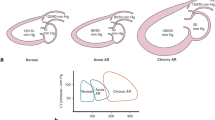Abstract.
Due to demographic changes in average life expectancy, the age of patients undergoing cardiac surgery is increasing. We have reviewed the short- and long-term outcome after aortic valve replacement with or without concomitant coronary artery bypass grafting in patients over 80 years of age. From 1 January 1995 until 30 June 1999, 114 patients (83 women and 31 men, 80–89 years of age, 82.8±2.4 years) with symptomatic aortic valve disease underwent aortic valve replacement. Of these patients, 54% (group A) received isolated valve replacement and 46% (group B) underwent myocardial revascularization as well. The perioperative mortality rate was 4.8% for group A and 7.7% for group B. The 30-day hospital mortality rate was 4.8% for group A and 15.4% for group B. The follow-up time ranged between 3 months and 63 months (32±15 months). None of the patients had to be reoperated for prosthetic valve dysfunction or endocarditis. Bleeding complications due to anticoagulation therapy were not observed. Of the 15 deaths during the follow-up period, seven (47%) were cardiac in nature and two (13%) were related to stroke. Actuarial survival rates for group A were 90%, 84%, and 76% at 1, 2, and 3 years, respectively, and for group B were 75%, 71%, and 68%. One year after the operation, permanent nursing care was not required by 100% of patients in group A (2 years, 98%; 3 years, 95%) and by 100% of patients in group B (2 years, 95%; 3 years, 91%). At a 1-year interval after the operation, 98% of patients in group A had not been hospitalized as a result of cardiac disorders (2 years, 98%; 3 years, 95%). The rates for group B were 90%, 85%, and 85%. Compared with younger age groups, aortic valve replacement in patients 80 years of age and older is associated with a distinctly increased mortality and morbidity. However, our data suggest that, considering the poor prognosis of conservative therapy of symptomatic aortic valve disease, functional status as well as life expectancy in this age group seem to be positively influenced by aortic valve replacement.
Similar content being viewed by others
Author information
Authors and Affiliations
Additional information
Electronic Publication
Rights and permissions
About this article
Cite this article
Ennker, J., Mortasawi, A., Gehle, S. et al. Aortic valve replacement with or without concomitant coronary artery bypass grafting in the ninth decade of life. Langenbeck’s Arch Surg 386, 272–277 (2001). https://doi.org/10.1007/s004230100221
Received:
Accepted:
Published:
Issue Date:
DOI: https://doi.org/10.1007/s004230100221




